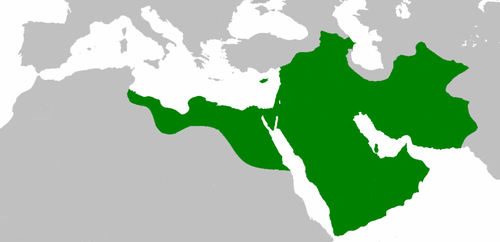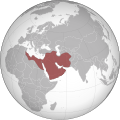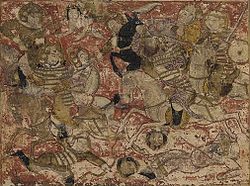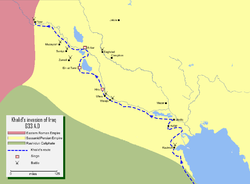Rashidun Empire
Rashidun Empire or the Islamic Empire (Arabic: الامبراطورية الاسلامية) or Rashidun Caliphate (Arabic: الخلافة الراشدية) are the terms used to describe the empire that was controlled by the first four successors of Muhammad (the "Rightly Guided" caliphs). The empire was founded after Muhammad's death in 632 and lasted until 'Ali's death in 661. At its height, the power of the Rashidun Caliphs extended throughout North Africa, the Arabian Peninsula, and the Iranian highlands.
Rashidun Caliphate الخلافة الراشدة | |||||||||||||||||||
|---|---|---|---|---|---|---|---|---|---|---|---|---|---|---|---|---|---|---|---|
| 632–661 | |||||||||||||||||||
 The Rashidun Caliphate reached its greatest extent under Caliph Uthman, in 654. | |||||||||||||||||||
| Capital | Medina (632–656) Kufa (656–661) | ||||||||||||||||||
| Common languages | Classical Arabic | ||||||||||||||||||
| Religion | Islam | ||||||||||||||||||
| Government | Caliphate | ||||||||||||||||||
| Caliph | |||||||||||||||||||
• 632–634 | Abu Bakr (first) | ||||||||||||||||||
• 634–644 | Umar | ||||||||||||||||||
• 644–656 | Uthman | ||||||||||||||||||
• 656–661 | Ali | ||||||||||||||||||
• 661–661 | Hasan (last)[a] | ||||||||||||||||||
| History | |||||||||||||||||||
• | 8 June 632 | ||||||||||||||||||
• | 28 July 661 | ||||||||||||||||||
| Area | |||||||||||||||||||
| 655[3] | 6,400,000 km2 (2,500,000 sq mi) | ||||||||||||||||||
| Currency | Dinar Dirham | ||||||||||||||||||
| |||||||||||||||||||
Origin
After Muhammad's death in 632, the Medinan Ansar were debating who -among them- should succeed prophet Muhammad in running the affairs of the Muslims. They chose Abu Bakr. So he became the first Khalifa Rasul Allah (Successor of the Messenger of God), and started a campaigns to for the Muslim Religion. At first he the Arabian tribes which had left the Islamic community. As a Khalifa or Caliph he was not a monarch and never claimed such a title. His three successors also never claimed a title as monarch.
The first general of the empire was Khalid ibn Walid. During his campaign against the Persian Empire(Iraq 633 - 634) and Byzantine Empire (Syria 634 - 638) Khalid developed brilliant tactics. The Caliph Abu Bakr's way was to give his generals their mission, the geographical area in which that mission would be carried out, and the resources that, could be made available for that purpose. He would then leave it to his generals to accomplish their mission in whatever manner they chose, on the other hand Caliph Umar in later part of his Caliphate used to direct his generals as to where they would stay and when to move to the next target and who will be commanding the left and right wing of the army in the particular battle, this made the phase of conquest comparatively slower but provided well organized campaigns. Caliph Uthman used the same method as of Abu Bakr, he would give missions to his generals and then leave it to them how they accomplish it. Caliph Ali also followed the same method.
Religion
The state religion was Islam. The non-Muslim people were allowed to practice any religion they want to follow.[4] But the Sharia Law was practiced in the state. Islam was the guiding force of the Caliphate. Any act of state was first to be approved by the Qur’an and the Traditions of the Prophet Muhammed. If there were no such guide lines available then wisdom or Hikmat was used, after which if the act would go against the established principals, norms,system etc. it was not carried on with.
Rashidun Empire Media
Sasanid style coins were in circulation during the Rashidun period, (Pahlavi scripts, with crescent-star, fire altar, depictions of the last Sasanian emperor Khosrow II, added Arabic bismillāh in margin)
Rashidun Caliphate at greatest extent (orthographic projection)
Islamic conquests 622–750:* Expansion under Muhammad, 622–632* Expansion during the Rashidun Caliphate, 632–661* Expansion during the Umayyad Caliphate, 661–750
One of the rare archaeological findings -possibly- from the early Islamic period; transcription of a undated rock inscription found in Saudi Arabia in 2012, without definitions such as Caliph or Amir al-Mu'minin, claimed to be Umar's signature
Illustration of the Battle of Siffin, from a 14th-century manuscript of the Tarikh-i Bal'ami
Map detailing the route of Khalid ibn al-Walid's conquest of Iraq
References
- ↑ Abu Dawud, Kitaab us-Sunnah, Chapter on the Khulafaa, Hadith no. 4647
- ↑ فريد, أحمد [in العربية]. "من أعلام السلف – ج 1". IslamKotob – via Google Books.
- ↑ Rein Taagepera (September 1997). "Expansion and Contraction Patterns of Large Polities: Context for Russia". International Studies Quarterly. 41 (3): 495. doi:10.1111/0020-8833.00053. JSTOR 2600793.
- ↑ Christians and Jews as 'people of the Book' had some better treatment than the followers of other reliogions.
Notes






